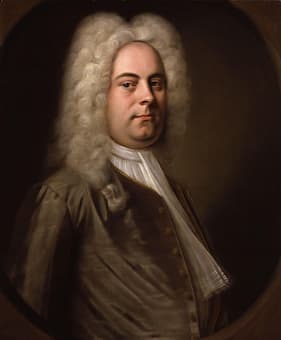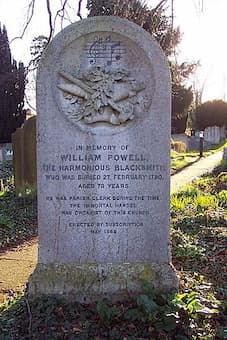
George Frideric Handel
I am sure you have heard numerous piano students slugging their way through the final movement of George Frideric Handel’s Suite No. 5 in E major. This particular movement has gained notoriety because it carries the imaginative nickname “The Harmonious Blacksmith.” That nickname does not come from Handel, and only appeared early in the 19th century when the movement became popular on its own. The legend of the famous nickname suggests that Handel, while working for the future Duke of Chandos between 1717 and 1718, was surprised by a sudden violent storm while taking a walk. By chance, he spied the workshop of a blacksmith and sought shelter. While he was watching the men at work, he was attracted by the melodious tones of the hammers as they struck the anvil. Keeping this ‘musical’ scene in mind, he later composed the movement, with the regularly repeated pedal note in the first variation giving the impression of a blacksmith hammering.

Grave of William Powell
A slight variation of the story suggests that Handel heard the blacksmith singing a tune, which later became the “Air.” So much for the legend, which was first published in the “Reminiscences of Handel” in 1836 by Richard Clark. To substantiate his imaginative story, Clark found an old anvil in a blacksmith shop near Whitchurch, Edgware. And he identified a certain William Powell as the fictitious blacksmith. He even raised a subscription for a wooden memorial to Powell, and in 1868 a further subscription replaced the wooden structure with a more permanent gravestone. The inscription reads, “In memory of William Powell, the Harmonious Blacksmith, who was buried 27 of February 1780, aged 78 years. He was Parish Clerk during the time the immortal Handel was organist of this church. Erected by subscription, May 1868.” The memorial to Powell still stands, but it was a blacksmith’s apprentice from Bath by the name of William Lintern, who later claimed to be the harmonious blacksmith. Brought up as a blacksmith, Lintern turned to music, and since he was constantly asked to play that movement, the title of Harmonious Blacksmith was actually given to him. Hard to say whether we will ever discover the true source of the nickname, but when listening to a performance by Sergei Rachmaninoff it hardly matters.
For more of the best in classical music, sign up to our E-Newsletter
George Frideric Handel: “Harmonious Blacksmith” from Harpsichord Suite No. 5 in E major HWV 430


